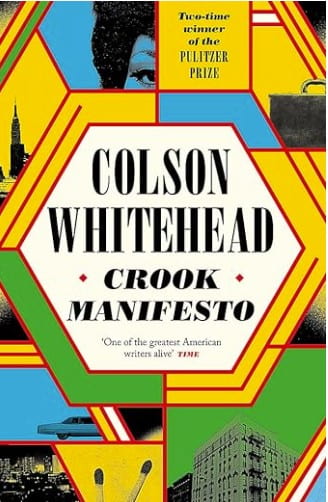It took me quite a while to get into this book. It is dense with events – crime mostly – and seemed a never-ending list of them. But halfway through, it made more sense and even moved into the wonderful category.
The story continues from Harlem Shuffle but can be read as a stand alone. We meet Ray Carney again in 1971, the furniture store owner who is now successful and trying to go straight in a crime-ridden, violent and corrupt city. The trouble with being a family man is that you want to please your family and so when your daughter asks for tickets to a Jackson 5 concert that has sold out, what can you do? Well, move back over the line and become a crook again, but this has consequences.
Crooked stays crooked and bent hates straight. The rest is survival.
p51
This leads Carney to a corrupt cop, Munson and from there to ever bigger crimes and trouble, not unlike a noir where the killer goes on a spree.
Jump forward a few years and we are in 1973 and Carney’s store is being used as a set for a blaxploitation film and this brings crime through financers, drugs and security needed on set. When the leading lady goes missing, Pepper is tasked with finding her and the trail he leaves in doing so is quite devastating. Here the idea of a crook having a set of ethics is set
The third and last section or novella is set in 1976 when the city is going up in flames – arson is the leading crime and everyone is in on the act: insurance companies; lawyers and their firms, landlords and tenants. It is a way out of troubles and into money and here we get an impassioned speech about how the city has come to sink this low. Carney believes that it isn’t arson but shitty urban planning that is biting them in the ass. It’s about cutbacks, moving people, making their living spaces smaller, knocking down factories and places of work, closing local fire stations and the homeless moving into empty buildings. In fact it is an unwritten policy of the city that it is cheaper to burn a place down than renovate or improve for the people. And, of course this all affects those with the least power to stop it, the least wealthy communities and those with people of colour. And this is really what this book is all about. Those who benefit, the politicians, planners, developers and financers, make profits from poverty whilst the city spirals down into the sewers.
What drives Carney to seek out those who burnt down a local building is the fact that an 11year old boy was caught in the fire.
What put the Ruiz boy in the hospital – the fire or everything that made the building empty in the first place?
p261
The book is quite remarkable. The three novellas, or what feel like episodes in a TV series, chart the changes in crime and the deterioration of the city with Carney holding still as a fence and a crook whilst all around goes to the dogs. Or as Whitehead puts it, it feels like the city is ‘wrapped in a bum’s dingy overcoat.’ It has moments of noir and moments when it is a hard-boiled crime novel ‘trouble was making good time to his front steps but he beat it by twenty minutes’ but there are also motifs that are more unusual. For instance, the furniture.
I wondered why these books were set in a furniture store but of course it gives you the persepective of looking out onto a city, where people pass by, where you can watch from safety and also can be used as a front. The furniture also suggests class, wealth and social mobility: the DeMarco leather sofa, the birch Egon coffee table, the Sterling expandable dining table the anchor piece of their 1976 Glamorous Living line and let’s not forget the recliners. And, it’s also funny.
Each episode also has a word woven into the story. So for 1971 it is ringolevio, a tag game with teams and a jail where you need to place the opposition. It goes on and on, no time limits and I suppose life in Harlem at this time must have felt very like this game. In the second episode ghosts are mentioned but I didn’t pick up on it as much as the words in the first, and in the third there is the rock that Manhattan is built on, the schist.
1976 is the bicentennial of the city but in Carney’s eyes a hunk of rock has more history. The book details how the city, and this rock, shapes people – not because they are lazy or criminal but because of the policies enacted by those who were supposed to be helping the population to improve their lives.
The apartment on 127th Street, the madness of Harlem, the white world and its quick, mean hands – he’d had to grow a concrete skin for a concrete city. Not concrete, something harder, like schist.
p296
The city had tried to break him. It didn’t work. He was genuine Manhattan schist and that don’t break easy.
p321
We are left set up for the third in this series of books. Suggestions of Elizabeth, Carney’s wife, opening her own travel agency and of course the 1980s. Another time when the city sank into its own sewers aided and abetted by the greed of the rich.
